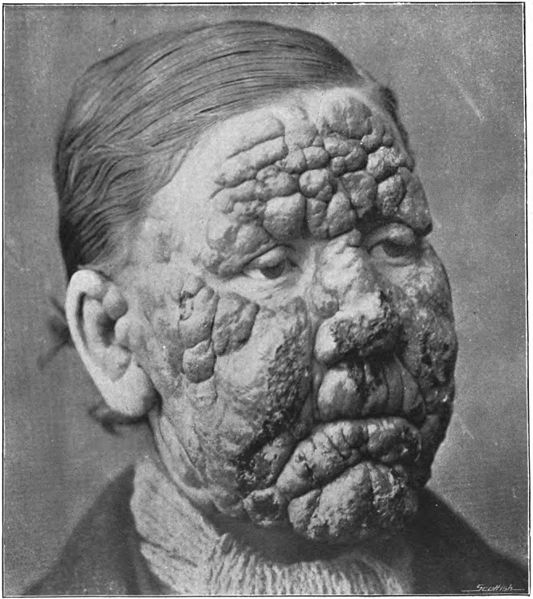Hansen’s Disease was not considered an epidemic in the United States until the 1880s. The first time Hansen’s Disease was considered an epidemic in the United States was when the disease affected 4.5 out of 100,000 people in New Orleans. Hansen’s Disease is most common in tropical and subtropical regions. New Orleans has played a distinct role in the history of Hansen’s Disease in the U.S.

A man with leprosy. Photo taken by Norman Walker.
Hansen’s Disease is an infection caused by the bacteria Mycobacterium leprae and Mycobacterium lepromatosis. The primary external sign of leprosy are skin lesions. Early signs of the disease often happen in cooler parts of the body, and usually the body parts lose their sense of sensation. If left untreated, the disease can be very destructive to the body, causing permanent damage to the skin, nerves, limbs, and eyes. The disease can completely numb body parts. According to the Indiana State Department of Health, there is no cure for Hansen’s Disease but there are methods to keep the disease dormant in bodies affected by it (Elwood, Julia Rivera. _Known simply to the rest of the world as Carville 100 years_. November 1994. Print. Page 23).

An armadillo, a common carrier of the disease. Photo by Marius LLC.
Hansen’s Disease is a tropical and subtropical disease, thus it is most prevalent in those areas. This is due to the climate being warm year round, which keeps the bacteria reproducing. In tropical areas where certain diseases are prevalent, usually those diseases have animals that serve as host for the disease. The New York Times found that, in Louisiana, the animal carrier for Hansen’s Disease is the armadillo (Gussow, Z. _Leprosy, Racism, and Public Health: Social Policy in Chronic Disease Control._ Boulder: Westview Press, 1989. Print. Pages 44, 45, 51, 57). Due to modern science, Hansen’s Disease is not a disease the public considers to be at risk of catching, but due to New Orleans’s subtropical climate, it was a large principle in writing New Orleans’s history.
The first recording of Hansen’s Disease was in 600 B.C. (“Hansen’s Disease.” Indiana State Department of Health. Web. 31 July 2013. http://www.in.gov/isdh/22113.htm). According to author Zachary Gussow, it was not until 1888 when New Orleans’ Charity Hospital data was released that New Orleanians had to face the facts that Hansen’s Disease was an epidemic, especially among the local white population. With rampant epidemics of Yellow Fever in New Orleans during that era, many feared that there was a connection between Hansen’s Disease and Yellow Fever. While Louisiana officials were trying to figure out where to quarantine all people affected by Hansen’s Disease, Charity Hospital was one of the only facilities that admitted people with Leprosy.
In 1894, the first Leprosarium in the United States was opened in Baton Rouge, Louisiana. The Carville Leprosarium was just outside Baton Rouge, in an abandoned plantation home. The first few years that it was open, patients lived in the slave quarters while workers worked vigorously to get the plantation house up and running. The first seven patients at Carville Leprosarium were from New Orleans. Dr. Isadore Dyer, a dermatologist and leprologist from Tulane University Medical School, established the Control Board for the Louisiana Leper Home as, “a place of refuge, not reproach; a place of treatment and research, not detention.” Due to its proximity and long history with leprosy, doctors from New Orleans worked at or sat on organizing boards for the Louisiana Leper Home (Harris, Gardiner. “Armadillos Can Transmit Leprosy to Humans, Federal Researchers Confirm.” _New York Times_. Web. 31 July 2013. http://www.nytimes.com/2011/04/28/health/28leprosy.html?_r=0.).
The spread of Hansen’s Disease is still a mystery to doctors. The most commonly accepted theory is that the disease is spread through the upper respiratory tract and abraded skin. The actual contraction of the disease is rare, in fact 90 percent of the world’s population has a natural immunity to Hansen’s Disease. Also, doctors who work with people who have Hansen’s Disease rarely ever get infected. “It is rumored that doctors at Carville tried to give [Hansen’s Disease] to themselves but were unsuccessful.” Surprisingly, after being infected with Hansen’s Disease, it can sometimes take five to seven years for the disease to show its first symptoms. There is no cure for Hansen’s Disease. However, in 1941, Carville Leprosarium had a breakthrough when introducing sulfone drugs. This helped many people, causing the disease to become dormant in their systems. Since some suffers are sulfone resistant, doctors often prescribed rifampin, clofazimine, and ethanolamine, which can also ease symptoms (“Leprosy.” World Health Organization. Web. 31 July 2013. http://www.who.int/mediacentre/factsheets/fs101/en/).
Today, Hansen’s Disease can still be found in Angola, Brazil, the Central African Republic, the Democratic Republic of Congo, India, Madagascar, Mozambique, Nepal, and the United Republic of Tanzania. All of these countries have warm sub-tropical or tropical climates like New Orleans. Since the 1980s, more than 14 million cases have been cured. As of 2009, 244,796 new cases were found around the world(“Leprosy Today.” National Institute of Allergy and Infectious Disease. Web. 31 July 2013. http://www.niaid.nih.gov/topics/leprosy/understanding/Pages/today.aspx).
While there are still people affected by Hansen’s Disease, the numbers are reducing due to all the research and breakthroughs that occurred at Carville Leprosarium. Since its establishment in 1894, Carville Leprosarium thrived due to Louisiana doctors and Tulane University doctors who devoted most of their lives to searching for a cure and helping those who were affected by the disease. As a result, New Orleans and Louisiana played mayor roles in shaping the history of Hansen’s Disease in the U.S.
 NOLAbeings
Multimedia artist Claire Bangser created NOLAbeings as a portrait-based story project that marries...
NOLAbeings
Multimedia artist Claire Bangser created NOLAbeings as a portrait-based story project that marries...
 Data corner: Adobe Suite (create a PDF, social media graphic, presentation, edit a photo and video
Data corner is where you go to work with analytics and top tech skills. It takes on everything from PERL and SQL to Canva and Sprout Social.
Data corner: Adobe Suite (create a PDF, social media graphic, presentation, edit a photo and video
Data corner is where you go to work with analytics and top tech skills. It takes on everything from PERL and SQL to Canva and Sprout Social.
